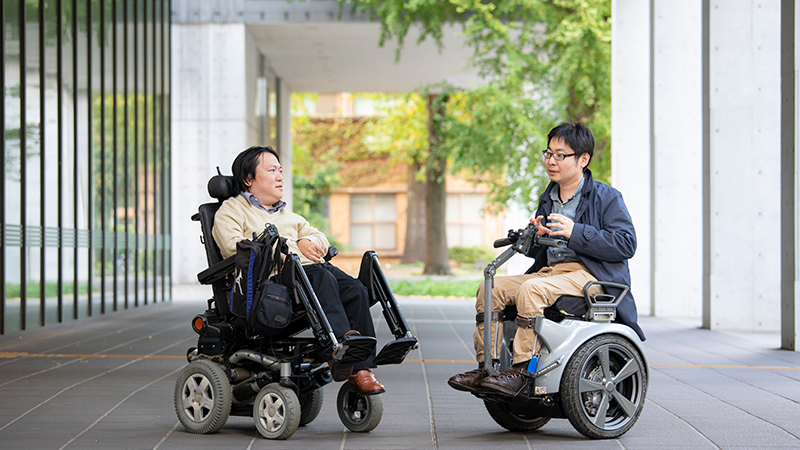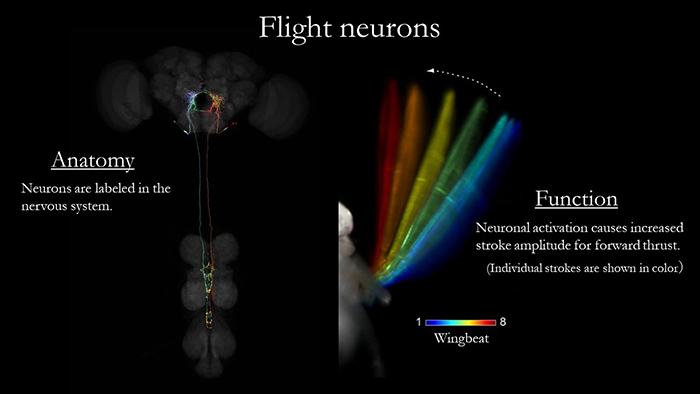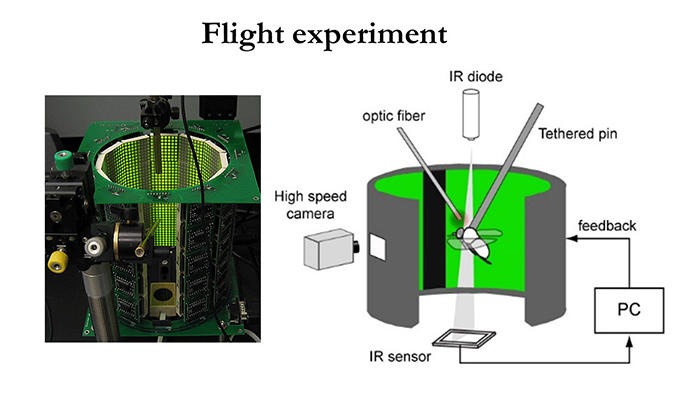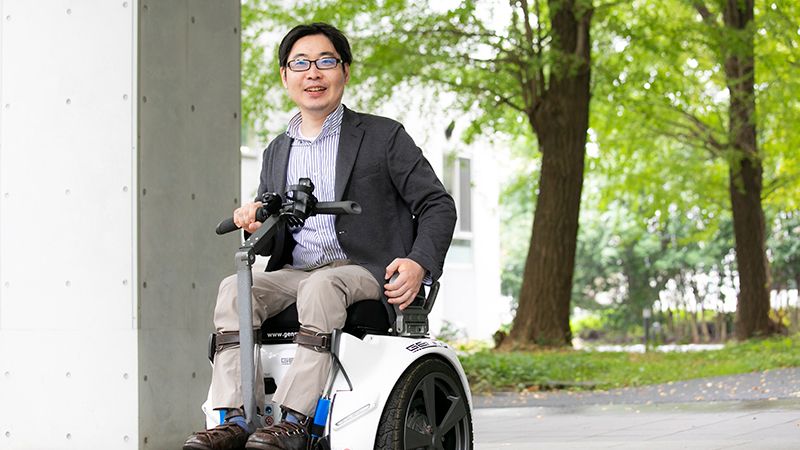- HOME
- Research
- Our Researchers
- Designing an accessible laboratory : Associate Professor Shigehiro NAMIKI
Designing an accessible laboratory : Associate Professor Shigehiro NAMIKI
Associate Professor Shigehiro NAMIKI

Shigehiro NAMIKI
Inclusive Design Laboratory
Barrier-free research : Designing an accessible laboratory
Aiming for an academic environment that does not limit the careers of people with illnesses and disabilities.
Most STEM (science, technology, engineering and mathematics)-related research requires substantiation by experiments. Recently, manufacturers have been developing more and more research equipment that can be used even by students who are just starting out in research. However, for students with illnesses and disabilities, it is difficult to complete all the various tasks involved in conducting experiments.
Associate Professor Shigehiro Namiki has launched an “inclusive design laboratory”, which aims to build a barrier-free environment where even people with illnesses and disabilities can still have an academic career. Associate Professor Namiki, who himself is a biology researcher, is living his life in a wheelchair. We talked to him about making a barrier-free and accessible laboratory a reality, and the kind of future he is aiming for.
Making a barrier-free laboratory a reality
STEM researchers need to complete an extremely diverse range of tasks. For instance, conducting a bio-based experiment involves a variety of steps such as taking a test reagent off a shelf and peering at it under a microscope, then using special devices to siphon up the solution multiple times, and measuring micro amounts of chemicals with an electric scale.
For people with illnesses and disabilities that restrict their movements, and who have sight and hearing impairments, it isn’t easy to pursue research in the experiment-based STEM fields. Associate Professor Namiki comments there are many such people who, right from the start, give up on becoming a researcher in these fields.
“According to a survey conducted in America, STEM students with disabilities account for 11% of all students in these fields at the undergraduate level. This ratio falls drastically at the graduate level, and drops even further to around 1% at the doctorate level. I cannot comment accurately on the situation in Japan, since a similar survey hasn’t been done here; but if this what it is like in America where support for the physically disabled is quite advanced, then there are probably even fewer such students in Japan.”
When Associate Professor Namiki developed a serious illness that restricted movement in his legs, he temporarily gave up on pursuing a career in research and even tried changing his profession. But after coming to know about two RCAST researchers on the Center’s website, he had a change of heart.
They are Associate Professor Shin-ichiro Kumagaya, who is confined to life in an electric wheelchair due to cerebral palsy, and Professor Satoshi Fukushima, who is both deaf and blind. Both professors have been researching barrier-free access and disabilities from the perspective of the tojisha – the person with the disability. Associate Professor Namiki was encouraged by the activities of these professors, who were pursuing their research even while having illnesses and disabilities; it made him think, “maybe I can do the same?”
Associate Professor Namiki started attending Associate Professor Kumagaya’s lectures, and eventually the pair began networking with each other. Together with Associate Professor Kumagaya and other faculty staff, he then became a member of The University of Tokyo’s Inclusive Academia Project .
The Project supports the studies and research of a diversity of people, and aims to create an inclusive campus for everyone. Spearheaded by RCAST, the Inclusive Academia Project is being rolled out across all departments in The University of Tokyo.
Associate Professor Namiki is in charge of the structural aspects of creating a barrier-free environment, specifically by making places more physically accessible and handling the legal and policy areas. He is particularly focused on researching and developing an inclusive laboratory, where even STEM students and researchers with illnesses and disabilities can freely conduct experiments.

How can students with disabilities handle doing experiments?
“What I’m aiming for in my research of an inclusive laboratory is creating an environment that does not limit the careers of people with illnesses and disabilities. And then, I’d like those to people find a career path where they can make use of their disabilities. So I’m currently looking at the design of laboratories, preparing guidelines and doing other such tasks; basically, I’m taking a multifaceted approach to roughly four research themes.”
The first is preparing guidelines to support students with disabilities. The reality is that in Japan, assistance for students and researchers with disabilities to conduct experiments is either lagging or non-existent to begin with.
“For example, the American Chemical Society’s guidelines on “Teaching Chemistry to Students with Disabilities” includes standards on laboratory design, such as the width of doors and corridors in laboratories. So I’m referring to these kinds of leading examples from overseas while preparing the guidelines, and adjusting them in line with the laws and culture of Japan so that they reflect the situation here.”
The second is putting together a collection of case studies. This involves interviewing people with disabilities who are working in STEM fields, and researching their experiences during university and at work, as well as gathering information on overseas case studies through literature and other sources. Building a database of such information will make it easier to clarify ways to provide specific support. Associate Professor Namiki hopes these case studies will also be useful to youth with disabilities, when it is time to choose their future career path.
The third research theme is analyzing the movements required to conduct an experiment. Applying the “work analysis” method used in occupational therapy to scientific experiments as well will enable a detailed understanding of the physical abilities required for certain movements, and can provide clues as to the type of support needed.
“The fourth theme is actually building a laboratory. So that means using the guidelines we’ve prepared to build and use a laboratory that meets barrier-free standards. At the same time, we will also implement and trial a variety of technologies not included in the guidelines. First, I want to use myself as an example, and try out various settings that allow people with restricted leg movements to conduct experiments. I’d like to keep on incorporating whatever I can to make the laboratory environment more barrier free, such as setting specifications for standing-style wheelchairs, developing height-adjustable experiment stands, and using robots. My plan from hereon is to expand my research to include environments for people with sight impairments and other disabilities.”

As a person with a disability (tojisha) and also a STEM researcher himself, Associate Professor Namiki has the right background and skills to understand the needs of these researchers, and build a STEM research laboratory designed for people with disabilities and illnesses. Associate Professor Namiki hopes that once this barrier-free laboratory becomes a reality, he will be able to resume his research on insects, which he has stopped doing since being confined to a wheelchair. So, what is he aiming for in this research on insects?
“That robot” modelled on insects
“Using insects as a model, I have been attempting to explain animal behavior based on movements of the nervous system. Insects share some of the same pathogenic genes as humans, so they can be used as a model for researching humans. Insects also have a brain, but its structure is much simpler than the human brain; so it is easier to analyse an insect’s brain and use it as a model.”
Optogenetics is a technique in which light is shone on a living organism (animal) to arbitrarily control its neural activity. This technique has made it possible to also understand in detail the neural activity, as well as control only a specific single cell in a genetically-modified organism. Associate Professor Namiki has been using optogenetics to identify the nerves related to flight in the fruit fly.


Research on insects is not just interesting because these organisms can be used as a model for studying human behavior. Associate Professor Namiki is also fascinated by the unique behavioral principles of insects, and he explains the possibilities of researching these organisms.
“Although insects are small, just like other organisms, they perform a complex set of behaviors. Moreover, insects have fewer nerve cells and limited resources they can use, and so they have uniquely evolved and developed an original way to control their behavior. Unlike humans who have a vast neural network with a large brain as the central “commander” in charge of the surrounding nerves, in insects the nerves are dispersed and independent, and they act autonomously for each function. I find that kind of strategy to be fascinating, and I think humans can also learn something from studying it.”
Associate Professor Namiki mentions how the behavioral principles of insects is also being applied in robotics. In 1991, an American researcher developed the six-legged insect-like robot “Genghis.” This model has been applied and commercialized to create the autonomous household cleaning robot “Roomba.” If you’ve ever looked at a Roomba as it bumps into objects and then changes direction and thought, “it moves just like a living organism”, well, your hunch is correct.
Inclusive Design Laboratory – Paving a path for the future
Associate Professor Namiki set his sights on becoming a researcher when he was a child. Although he wasn’t too fussed about any particular field, he recalls wanting to do research on insects that would also benefit humans. He is currently working in the lab of RCAST Director, Professor Ryohei Kanzaki, and although mice have also featured in his studies, Associate Professor Namiki’s ongoing research has been on insects - even when studying and working abroad. Essentially, the basic neuronal mechanism of behavior has been a consistent theme of his research. So what is his mindset now, as he approaches a completely new research theme of inclusive design?
“Barrier-free research is highly likely to be of immediate benefit to humans, and it is also interesting in a way that’s different to basic research. Of course, I still believe in the usefulness of research on insects, and that’s why I have continued with it. However, the benefits of such research are likely to be realized not immediately, but rather several decades from now – or even a hundred years later, when I’m no longer alive. I also like how the keyword of “barrier free” lets me connect with people in a range of fields. It gives me the opportunity to talk to people with disabilities and other relevant persons and hospital staff, as well as those who provide support to these people and who create the technologies that help support them. This kind of research work makes me feel a sense of purpose.”

The Inclusive Academia Project aims to create an inclusive campus where no one is left behind. Yet, there are cost issues, legal concerns and many other such barriers to achieving this vision. Associate Professor Namiki is unperturbed though; he intends to steadily overcome each of these barriers, one by one.
“This Project has really only just begun. Even when it comes to creating guidelines, we need to start with a debate about whether they should even be created to begin with. If the decision is to prepare a set of guidelines, they should be of practical use – and that will require us to negotiate with universities and various manufacturers.”
Almost every one of us will be afflicted by illnesses and disabilities as we age. In today’s society, where living to one hundred is vast becoming a reality, initiatives to create a barrier-free environment should be seen as relevant to everyone. If we can realize an academic environment that does not limit research careers due to illnesses and disabilities, then just consider the talent that can thrive in such a setting. Ahead of Associate Professor Namiki’s research is a world of potential that we can still only imagine.

After acquiring a PhD (Natural Science) from the Graduate School of Life and Environmental Sciences, University of Tsukuba, Namiki worked as a postdoctoral associate and later as a research scientist at the Janelia Research Campus of the Howard Hughes Medical Institute in the United States; he continues to work there as a consultant. From June to December 2015, Namiki paused his research work to recover from an illness. He was appointed as a Project Research Associate at RCAST in 2009, and since then he has held successive posts as Project Lecturer and Project Associate Professor. Namiki was appointed to his current post as Associate Professor in April 2020.
Tags

